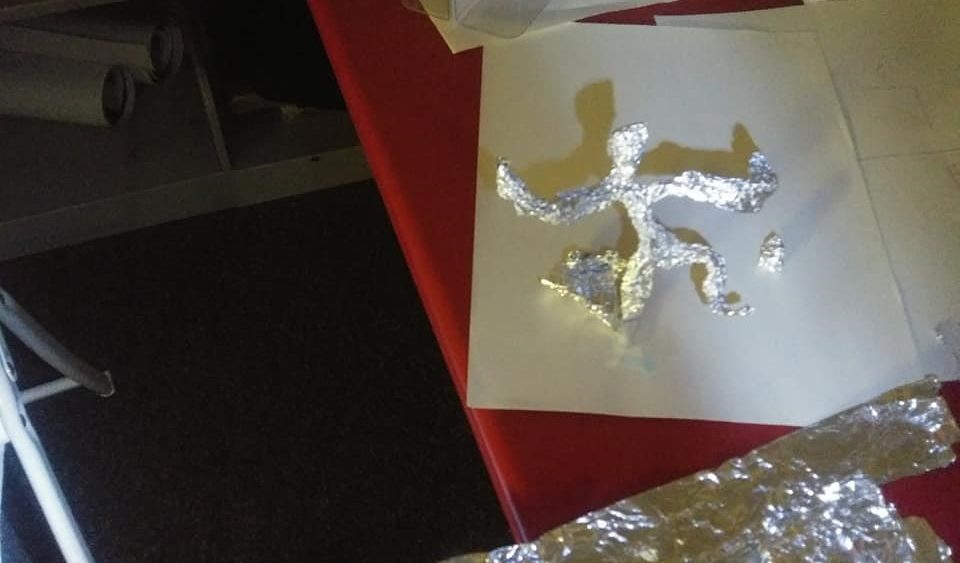
Archimedes needed only a lever. Newton just needed an apple tree. And the kids of Southeastern North Carolina need nothing more than their local library to be up to their ears in science!
In 2007, the esteemed Franklin Institute Science Museum in Philadelphia launched its Leap into Science program. With the aim of improving skills in science and literacy for kids aged 3 to 10, the Institute developed a curriculum expressly designed to be taught outside traditional classrooms. Instead of relying just on teachers in schools, Leap into Science reaches underserved students and their families right in their own communities at libraries and museums as well as schools.
 In 2020 shortly before COVID changed everything, a group of organizations in North Carolina received a grant to launch Leap into Science in NC. With COVID restrictions in place, the design of the program had to change. Undaunted, two educators saw the need as critical as ever to bring STEM education to geographically disadvantaged and underserved students by adopting the Leap into Science program.
In 2020 shortly before COVID changed everything, a group of organizations in North Carolina received a grant to launch Leap into Science in NC. With COVID restrictions in place, the design of the program had to change. Undaunted, two educators saw the need as critical as ever to bring STEM education to geographically disadvantaged and underserved students by adopting the Leap into Science program.
For 15 years, Pepper Hill served as an educator and field trip coordinator at Cape Fear Museum, and she notes that she rarely met students from rural counties and almost none from those counties between the Triangle and the beach. “Some of these students simply couldn’t get to school, on a bus, to the museum, and back in a school day,” says Hill. “In this instance, the pandemic actually proved to be a fortuitous catalyst to look at out-of-school educational experiences in a whole new way.” She founded the Science Alliance in April 2020 using the Leap into Science curriculum as its foundation.
Similarly, Tomeka Roulhac, Branch Manager of the Hertford County Public Library in Winton, brought Leap into Science to her library in May 2021 and completed the first workshop in September. “There was a need to bring outside-of-school programming to underserved communities in a place they would be comfortable attending,” says Roulhac. She lauds the program as being an all-in-one recipe for success, including teaching tools and hands-on materials in every workshop. “Being a small-town library with a small budget,” says Roulhac, “we can’t do everything we’d like to do. Programs like this are a godsend.”
During COVID, these programs stepped in when classwork simply wasn’t accessible or sufficient, but, says Roulhac, Leap into Science is still a critical pillar to learning (even with kids back in school). “This program complements what kids learn in the classroom by expanding the knowledge they already have with a fun hands-on aspect. For younger kids, it’s more of an introduction to STEM and, with it being outside school, the setting is much less structured.”
While both Hill and Roulhac admit that it’s still a challenge to get people to attend the workshops, the fact that families are invited—and encouraged—to participate with their children is key to continued engagement. “I love the ‘whole family’ dynamic,” says Hill. “Parents are sometimes nervous when they attend a session, but all of a sudden, they’re holding a flashlight or flipping the pages in a book. Before they know it, their sleeves are rolled up and the whole family is engaged!”
 Each session developed by the Franklin Institute combines a literacy component and a hands-on element. So, for the inaugural Light & Shadow lesson, for example, Roulhac might read a page and then ask kids, “Who sees a shadow on this page? Where do you think the light might be coming from to make these shadows?” She raves that this was her favorite workshop because the students just loved running around in the dark with their flashlights, while their parents chimed in about the different shadow shapes their kids were creating.
Each session developed by the Franklin Institute combines a literacy component and a hands-on element. So, for the inaugural Light & Shadow lesson, for example, Roulhac might read a page and then ask kids, “Who sees a shadow on this page? Where do you think the light might be coming from to make these shadows?” She raves that this was her favorite workshop because the students just loved running around in the dark with their flashlights, while their parents chimed in about the different shadow shapes their kids were creating.
Kids don’t feel the pressure they might in a formal classroom, and parents are able to see first-hand what their kids are learning. They get to show their enthusiasm for their children’s education by actually getting their hands dirty together!
“I love teaching these sessions in the library,” says Hill. “We’re using literature to teach science. I read a little, then we experiment a little. Read and experiment.” She explains that even kids who self-identify as not very strong readers, fall in love with the program and embrace the literacy component as much as they do the hands-on activities. The program asks kids to open their minds by “noticing and wondering,” as they read, experiment, ask questions, and repeat.
Finally, both agree that simply being able to go somewhere as a family and do something, see something, try something new is absolutely what families are craving right now. Kids who were never able to attend field trips are engaging with a community organization in new and special ways, and families cooped up for the last year are able to enjoy engaging, educational activities right in their own neighborhoods.
The NC STEM Ecosystem is partnering with The Franklin Institute to create a network of NC educators to attend training and teach the Leap into Science curriculum across the state. To learn more about Leap into Science, visit www.leapintosciencenc.org.
